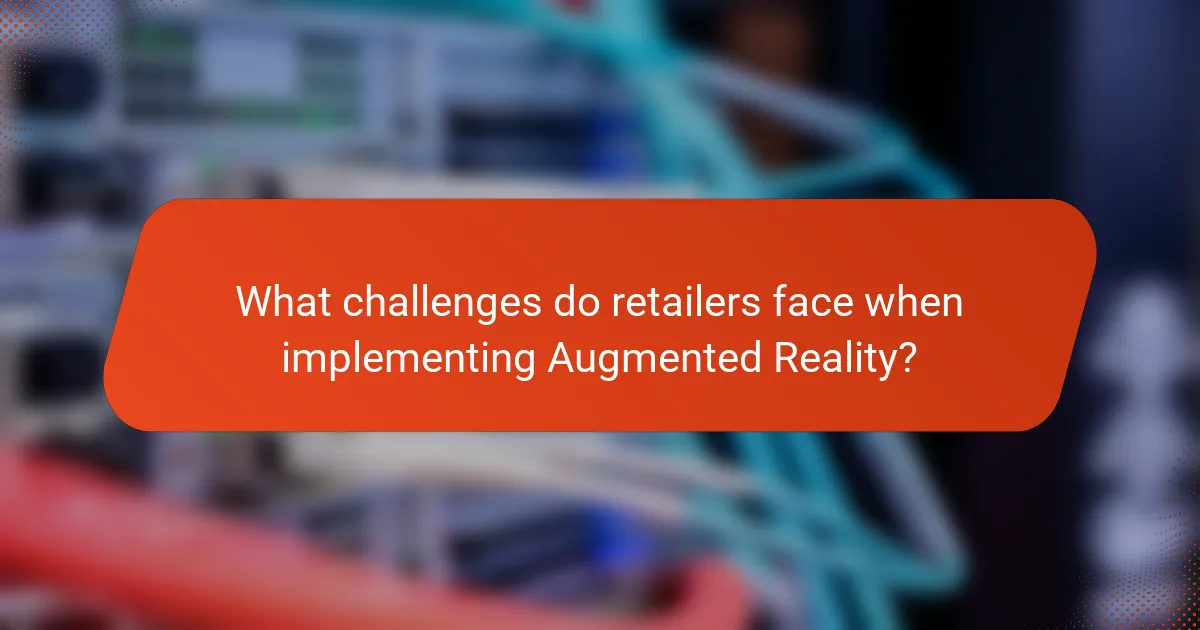Augmented Reality (AR) is transforming retail experiences by enhancing customer engagement and decision-making. Key developments in AR include virtual try-ons, interactive displays, and enhanced product visualization, allowing customers to visualize products in their own environments before making a purchase. Retailers like IKEA and Sephora are leveraging AR technologies to improve shopping experiences and boost sales, with studies indicating that AR can increase conversion rates by up to 40%. However, challenges such as high development costs, integration complexities, user adoption issues, and data privacy concerns remain significant barriers to widespread AR implementation in retail. This article evaluates the impact of AR on retail experiences and explores the challenges retailers face in adopting this technology.

What are Augmented Reality Developments in Retail?
Augmented reality developments in retail include virtual try-ons, interactive displays, and enhanced product visualization. These technologies allow customers to visualize products in their own environment before making a purchase. For instance, companies like IKEA use AR apps to let users see how furniture fits in their homes. Virtual try-on solutions from brands such as Sephora enable customers to test makeup virtually. According to a report by Deloitte, 88% of consumers prefer retailers that offer AR experiences. These developments enhance customer engagement and improve shopping experiences. Retailers are increasingly adopting AR to differentiate themselves in a competitive market.
How do Augmented Reality technologies enhance retail experiences?
Augmented Reality (AR) technologies enhance retail experiences by providing interactive and immersive shopping environments. AR allows customers to visualize products in their own space before making a purchase. For instance, furniture retailers like IKEA use AR apps to show how a piece of furniture would look in a customer’s home. This technology increases customer engagement and satisfaction. Studies indicate that AR can lead to a 20% increase in conversion rates. Additionally, AR can provide personalized recommendations based on customer preferences. Brands utilizing AR often report higher retention rates. Overall, AR transforms the traditional shopping experience into a more dynamic and informed process.
What types of Augmented Reality applications are used in retail?
Augmented Reality applications in retail include virtual fitting rooms, interactive product displays, and AR navigation. Virtual fitting rooms allow customers to try on clothes digitally. This technology enhances the shopping experience by reducing return rates. Interactive product displays provide detailed information through AR overlays. Customers can visualize products in their own environment using AR. AR navigation helps customers locate items in-store. These applications improve engagement and drive sales. Studies show that AR can increase customer satisfaction and purchase intent.
How do these applications differ in functionality?
Augmented reality applications differ in functionality based on their features and user interactions. Some applications focus on enhancing product visualization, allowing users to see how items fit in their environment. Others prioritize interactive experiences, enabling users to engage with virtual objects through gestures. Certain applications offer social sharing features, letting users share their experiences with friends. Additionally, some applications provide analytics for retailers, helping them understand customer behavior. The differences stem from the intended use cases and target audiences of each application. For instance, applications designed for furniture retail may emphasize spatial awareness, while those for fashion may focus on virtual try-ons.
Why is evaluating Augmented Reality important for retailers?
Evaluating Augmented Reality (AR) is crucial for retailers because it enhances customer engagement and drives sales. AR allows customers to visualize products in their environment, improving the purchasing decision process. According to a study by Deloitte, 40% of consumers are willing to pay more for a product if they can experience it through AR. Retailers can use AR to create immersive shopping experiences that attract and retain customers. Additionally, evaluating AR helps retailers understand customer preferences and behaviors, leading to more tailored marketing strategies. This evaluation can reveal the effectiveness of AR features in increasing conversion rates and customer satisfaction.
What metrics are used to assess the effectiveness of Augmented Reality in retail?
Key metrics to assess the effectiveness of Augmented Reality in retail include customer engagement, conversion rates, and user satisfaction. Customer engagement can be measured by tracking the time spent interacting with AR features. Conversion rates reflect how many users make a purchase after using AR. User satisfaction is often gauged through surveys and feedback on the AR experience. Additionally, return on investment (ROI) is calculated by comparing the revenue generated through AR initiatives to the costs incurred. These metrics provide a comprehensive view of AR’s impact on retail performance.
How can retailers measure customer engagement through Augmented Reality?
Retailers can measure customer engagement through Augmented Reality (AR) by analyzing user interactions and behaviors within AR experiences. Metrics such as time spent in AR applications provide insight into customer interest. Tracking the frequency of AR usage helps identify engagement trends. Retailers can also assess conversion rates by comparing AR users to non-AR users. Customer feedback collected post-AR experience can indicate satisfaction levels. Additionally, heatmaps generated from AR interactions reveal which features attract the most attention. Data analytics tools can aggregate this information for comprehensive reporting. Research shows that retailers using AR report a 20% increase in customer engagement metrics, validating the effectiveness of these measurement strategies.

What are the key impacts of Augmented Reality on retail experiences?
Augmented Reality (AR) significantly enhances retail experiences by improving customer engagement and decision-making. AR allows customers to visualize products in their environment before purchase. This technology can lead to increased sales, as studies show that AR can boost conversion rates by up to 40%. Additionally, AR provides interactive experiences, which can enhance brand loyalty. Retailers utilizing AR can differentiate themselves in a competitive market. Moreover, AR can reduce return rates by helping customers make more informed choices. As a result, the integration of AR in retail transforms the shopping experience into a more immersive and satisfying journey.
How does Augmented Reality influence customer behavior?
Augmented Reality (AR) significantly influences customer behavior by enhancing engagement and improving the shopping experience. AR allows customers to visualize products in their own environment. This visualization can lead to increased confidence in purchasing decisions. According to a study by Deloitte, 40% of consumers are more likely to make a purchase when they can visualize a product in their space using AR. AR also provides interactive experiences, which can increase time spent on a retailer’s platform. Research from Gartner indicates that 70% of consumers prefer brands that offer AR experiences. This preference can lead to higher customer loyalty and repeat purchases. Overall, AR shapes customer behavior by making shopping more immersive and personalized.
What psychological effects does Augmented Reality have on shoppers?
Augmented Reality (AR) has significant psychological effects on shoppers. AR enhances the shopping experience by increasing engagement and interaction. This technology allows shoppers to visualize products in their own environment, leading to improved decision-making. Research indicates that AR can increase consumers’ emotional connection to products. A study by Javornik (2016) found that AR applications can evoke positive emotions, thus enhancing customer satisfaction. Additionally, AR can reduce perceived risk by providing a clearer understanding of the product. Shoppers are more likely to make purchases when they feel confident in their choices. Overall, AR positively influences shoppers’ perceptions and behaviors in retail environments.
How does Augmented Reality affect purchase decisions?
Augmented Reality (AR) positively influences purchase decisions by enhancing consumer engagement. AR allows customers to visualize products in their own environment before buying. This interactive experience increases confidence in purchase choices. A study by Deloitte found that 40% of consumers are willing to pay more for a product they can experience through AR. Additionally, AR reduces return rates by helping customers make informed decisions. Research indicates that AR can increase conversion rates by up to 90%. Overall, AR creates a more immersive shopping experience, leading to increased sales and customer satisfaction.
What are the benefits of using Augmented Reality in retail?
Augmented Reality (AR) enhances retail experiences by providing interactive and immersive shopping environments. AR allows customers to visualize products in real-time within their own space. This leads to increased customer engagement and satisfaction. A study by Deloitte found that AR can boost conversion rates by up to 40%. Additionally, AR reduces return rates by helping customers make informed purchasing decisions. Brands like IKEA and Sephora have successfully integrated AR into their shopping apps. This technology also allows for personalized marketing experiences. Overall, AR transforms traditional retail into a more dynamic and user-friendly experience.
How does Augmented Reality improve customer satisfaction?
Augmented Reality (AR) improves customer satisfaction by enhancing the shopping experience. AR allows customers to visualize products in their own environment before purchasing. This capability reduces uncertainty and increases confidence in buying decisions. Studies show that interactive AR experiences lead to higher engagement levels. According to a study by PwC, 79% of consumers prefer to shop with AR. The technology also provides personalized experiences, catering to individual preferences. Enhanced product visualization can lead to higher conversion rates and reduced return rates. Overall, AR creates a more immersive and enjoyable shopping journey.
What role does Augmented Reality play in brand loyalty?
Augmented Reality (AR) enhances brand loyalty by creating immersive and engaging customer experiences. AR allows customers to visualize products in their own environment before purchase. This interactive experience fosters a deeper emotional connection to the brand. According to a study by the International Journal of Retail & Distribution Management, 61% of consumers prefer brands that use AR for product visualization. AR also increases customer satisfaction by providing personalized experiences. Enhanced satisfaction leads to repeat purchases and brand advocacy. Brands utilizing AR effectively can differentiate themselves in competitive markets. This differentiation plays a crucial role in building long-term loyalty among consumers.

What challenges do retailers face when implementing Augmented Reality?
Retailers face several challenges when implementing Augmented Reality (AR). High development costs pose a significant barrier. Creating high-quality AR experiences requires substantial investment in technology and expertise. Integration with existing systems can also be complex. Retailers often struggle to seamlessly incorporate AR into their current platforms. User adoption is another challenge. Customers may be unfamiliar with AR, leading to lower engagement. Technical issues can arise, such as software bugs or hardware limitations. These can disrupt the user experience and deter potential customers. Additionally, retailers must ensure data privacy and security. AR applications often collect user data, raising concerns about compliance and trust. Finally, measuring the effectiveness of AR initiatives can be difficult. Retailers need to establish clear metrics to assess the impact of AR on sales and customer satisfaction.
How can retailers overcome technological barriers in Augmented Reality?
Retailers can overcome technological barriers in Augmented Reality (AR) by investing in infrastructure and training. Upgrading hardware and software is essential for optimal AR experiences. Retailers should also focus on user-friendly applications to enhance customer engagement. Collaborating with AR technology providers can streamline integration processes. Additionally, providing staff training ensures effective use of AR tools. Research indicates that 61% of retailers believe AR improves customer experience (Deloitte, 2021). This investment can lead to increased sales and customer satisfaction.
What are the common technical issues faced in Augmented Reality deployment?
Common technical issues in Augmented Reality (AR) deployment include tracking failures, latency, and compatibility problems. Tracking failures occur when the AR system struggles to accurately identify and follow physical objects. Latency refers to delays in response time, which can disrupt user experience. Compatibility issues arise when AR applications do not function well across different devices or operating systems. Additionally, environmental factors like lighting can impact AR performance. User interface design challenges can also hinder usability. These issues can lead to a negative perception of AR technology in retail settings.
How can retailers ensure a seamless user experience with Augmented Reality?
Retailers can ensure a seamless user experience with Augmented Reality (AR) by focusing on intuitive design and robust technology. Intuitive design simplifies navigation and enhances user engagement. High-quality graphics and smooth animations improve the visual experience. Fast loading times are essential to prevent user frustration. Retailers should also provide clear instructions for AR features. Testing across various devices ensures compatibility and performance. According to a study by Statista, 61% of users prefer AR experiences that are easy to use. This data highlights the importance of user-friendly interfaces in AR applications.
What are best practices for evaluating Augmented Reality in retail?
Best practices for evaluating Augmented Reality in retail include setting clear objectives for the AR implementation. These objectives should align with business goals, such as enhancing customer engagement or increasing sales. Next, gather user feedback through surveys or focus groups to assess the AR experience. This feedback can highlight areas for improvement and user satisfaction levels.
Additionally, analyze key performance indicators (KPIs) like conversion rates and time spent interacting with AR features. These metrics provide quantifiable data on AR effectiveness. Conduct A/B testing to compare AR experiences against traditional methods. This helps determine the added value of AR in the retail context.
Finally, stay updated on technological advancements and industry trends. This ensures the AR solution remains relevant and effective. Following these practices can lead to a successful evaluation of AR in retail.
How can retailers gather feedback on Augmented Reality experiences?
Retailers can gather feedback on Augmented Reality experiences through surveys and in-app feedback tools. Surveys can be distributed post-experience to capture user satisfaction. In-app feedback tools allow users to rate their experience immediately. Retailers can also use analytics to track user interactions with the AR features. This data helps identify areas for improvement. Focus groups can provide qualitative insights into user perceptions. Observational studies can reveal how customers engage with AR in real-time. These methods collectively enhance the understanding of user experiences and preferences.
What future trends should retailers consider for Augmented Reality?
Retailers should consider personalization and immersive experiences as future trends for Augmented Reality (AR). Personalization will allow consumers to see tailored product recommendations based on their preferences. This can enhance customer engagement and satisfaction. Immersive experiences can create virtual try-ons for apparel and accessories. Such implementations can reduce return rates by helping customers make informed decisions.
Additionally, AR can facilitate interactive product demonstrations, allowing customers to visualize products in their own environment. This trend can significantly enhance the shopping experience. According to a report by Gartner, 100 million consumers will shop using AR online and in-store by 2025. Retailers adopting these trends can gain a competitive edge in the evolving market.
How might advancements in technology shape the future of Augmented Reality in retail?
Advancements in technology will significantly enhance Augmented Reality (AR) in retail. Improved hardware, such as faster processors and better displays, will enable more immersive experiences. Enhanced software algorithms will allow for real-time object recognition and interaction. High-speed internet connectivity will facilitate seamless integration of AR applications. Machine learning will personalize user experiences based on shopping behavior. According to a report by Statista, the AR market in retail is projected to reach $1.6 billion by 2025, indicating growing investment in this technology. These advancements will ultimately transform how consumers engage with products, leading to increased sales and customer satisfaction.
The main entity of this article is Augmented Reality (AR) developments in retail. The article provides a comprehensive evaluation of how AR technologies, such as virtual try-ons and interactive displays, enhance customer engagement and improve shopping experiences. It discusses the various applications of AR in retail, their functionality, and the psychological effects on shoppers, including increased purchase confidence and brand loyalty. Additionally, the article addresses the challenges retailers face when implementing AR, the importance of measuring effectiveness, and future trends that could shape AR’s role in retail. Key metrics for assessing AR’s impact on customer satisfaction and sales are also highlighted.




